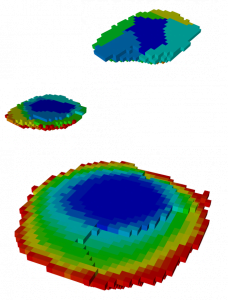Multi-mina
Reflejos
La gestión conjunta de varios pozos optimiza el cronograma y el valor de todo el proyecto.. El optimizador global de MiningMath analiza todas las minas simultáneamente para obtener resultados integrados.
- Permite la optimización integrada en todos los pozos, Evitar la programación aislada y la repetición del trabajo manual, Único en el modelado de interdependencias.
- Admite iteración rápida de escenarios mediante scripts de API, Reducir el tiempo de respuesta en comparación con los enfoques manuales.
- Su algoritmo globalmente óptimo, validado académicamente y en funcionamiento, maximiza la rentabilidad combinada de la mina.
El algoritmo de optimización global de MiningMath aborda eficazmente los desafíos de los proyectos multiminas integrados al considerar todos los pozos simultáneamente.. A diferencia de la optimización de pozos individuales, Este enfoque ofrece una solución integral que optimiza todo el proyecto., Proporcionar una visión general más cohesiva y estratégica.
No usar MiningMath?
Los proyectos multiminas a menudo encierran oportunidades ocultas para maximizar el valor. Dada su complejidad inherente, Es común aplicar simplificaciones que, mientras sea conveniente, Puede conducir a soluciones subóptimas cuando se utilizan metodologías LG/Pseudoflow tradicionales en lugar de MiningMath. Estas simplificaciones pueden, en última instancia, reducir el valor potencial del proyecto desde un punto de vista matemático..
Formateo del modelo de bloques
Para proyectos multiminas, El modelo de bloques debe incluir todas las regiones mineras para la optimización simultánea. Si sus pozos están mapeados en conjuntos de datos separados, Es esencial seguir los pasos que se describen a continuación:
Trabaje primero con un modelo de un solo bloque o un solo pozo, ejecute las pruebas iniciales y comprenda esta región antes de manejar la modificación del modelo de bloques.
Intenta eliminar los bloqueos sin sentido, que no afectaría la solución y podría aumentar la complejidad.
Agregar un segundo modelo o foso Explorar el proceso de trabajar con proyectos multiminas. Este archivo de modelo de bloque combinado debe cumplir los mismos requisitos que un modelo único, como se describe en el página de formato de datos, garantizar características unificadas.
Experimento con la superficie ajustes para refinar los resultados, Filtra las regiones que no deseas explotar, y aplicar otras orientaciones según sea necesario. Dado que los archivos de superficie de MiningMath mantienen un orden consistente, usando un archivo de Excel (disponible aquí) Puede ser una herramienta útil para estas modificaciones..
Usar frentes mineros Si desea controlar el material extraído de cada región.
Añade las demás regiones y empieza a usar todo lo que desees.
Uso de coordenadas UTM del mundo real
Al utilizar coordenadas UTM reales de minas que están geográficamente alejadas, El modelo de bloques combinados abarca un área enorme con grandes zonas vacías entre los depósitos.. Esto conduce a:
- Rendimiento significativamente más lento
- Mayor uso de memoria
- Posibles fallos de optimización
Simplificando con un sistema de coordenadas local
En lugar de utilizar directamente UTM, Introducir una simplificación, sistema de coordenadas local:
- Elija un origen arbitrario (p.ej, 0,0, 0) cerca de todos los depósitos
- Cambio (traducir) Las coordenadas de cada mina con un desplazamiento constante para que todas se alineen cerca del origen
- Esto reposiciona los modelos cerca unos de otros., eliminando espacio desperdiciado
Cómo traducir coordenadas
- Agregar (o restar) un valor fijo a X e Y Así que la mina se traslada al nuevo sistema.
- Coordenada Z Por lo general, puede permanecer igual si los rangos de elevación son similares entre las minas.
- Mina Un centro UTM original: (600000, 4 500 000)
- Mina B centro UTM original: (601000, 4 501 500)
- Definir origen = (600000, 4 500 000)
- Desplazamientos de traducción: A = (0, 0), B = (–1 000, –1 500)
- Nuevas coordenadas locales: A ≈ (0, 0), B ≈ (0, 0)
Asegúrese de que no haya superposiciones & Integridad del modelo
Después de la traducción y la integración:
- Comprobar que los diferentes modelos de minas no se superpongan espacialmente
- Confirmar que no haya conflictos en las asignaciones de bloques
- Validar todas las reglas geométricas (p.ej. frentes mineros, formas de hoyos) todavía tiene sentido
Restricciones geométricas
La versión actual de MiningMath aplica los mismos valores para tasa vertical, ancho de fondo, y ancho de minería en todo el modelo de bloques. Sin embargo, en un escenario de múltiples pozos, Cada pozo puede tener parámetros geométricos únicos que afectan la selectividad.. En estos casos, Recomendamos configurar los parámetros para un solo pozo., arreglando sus soluciones (como el forzar y restringir la minería Los ajustes tienen la máxima prioridad), y luego iniciar la optimización de los demás boxes. Este enfoque garantiza que la optimización considere la masa ya planificada para la extracción del primer pozo..
Ejemplo de flujo de trabajo
Un flujo de trabajo eficiente comienza ejecutando un escenario inicial sin parámetros geométricos que sirva como validación o el mejor escenario posible para la optimización de la programación. próximo, Configurar un escenario utilizando los parámetros geométricos de la mina más selectiva, es decir, los anchos más pequeños y la velocidad vertical más alta. (realidad virtual)—crear el escenario menos restringido en términos de geometría. Las superficies generadas a partir de esta configuración se pueden utilizar luego para fijar soluciones para Mine 1.
Por ejemplo, Podrías llevarte Surface 1 y ajustar la elevación en otras áreas para reflejar la masa extraída en el Período 1 de la mía 1, así como la posible extracción del segundo pozo. Con estos resultados, Puedes refinar superficies o frentes mineros, realizar una análisis de sensibilidad de los parámetros geométricos en múltiples proyectos, y aún así mantener los beneficios de la optimización global.





